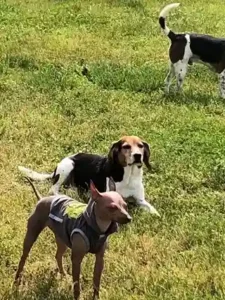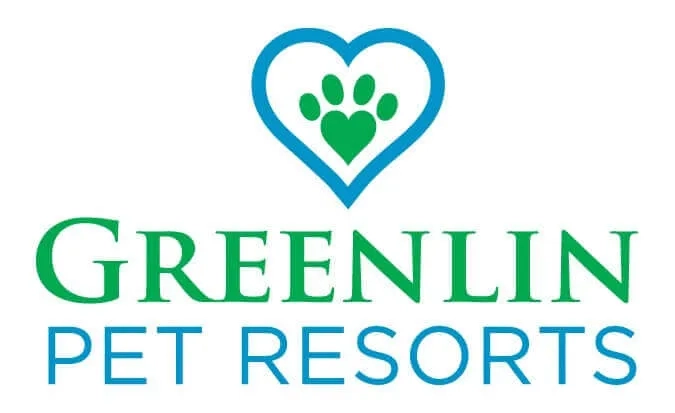Overcoming Dogpark Fear and Anxiety
 It’s normal for your dog to feel anxious the first time they visit a dog park, but repeated anxiety can get in the way of what should be an enjoyable experience.
It’s normal for your dog to feel anxious the first time they visit a dog park, but repeated anxiety can get in the way of what should be an enjoyable experience.
Anxiety can manifest itself in a variety of undesirable behaviors, including aggression towards other dogs, destructive playing behaviors, or attempts to escape fended in areas.
Luckily, there are ways to meet most dogs’ needs in order for them to find the enjoyment and exercise they deserve at the dog park. Finding the right treats, systems, and routines can help your dog get used to the dog park and make the entire experience more enjoyable for them.
Of course, if you’re getting ready to bring your puppy to the dog park – make sure to study up before you head over. It’s important to set the right expectations and learn the warning signs to look out for before you bring your new puppy into an unfamiliar environment.
In some cases, dogs will need training in order to achieve the goals set by their owner and enjoy visits to the dog park as expected. In other cases, the dog park may be more stressful or offer more drawbacks than alternatives, like supervised dog daycare.
Ultimately, owners must come to a decision on how to best meet their dog’s needs for socialization and exercise after speaking with their vet and certified dog training experts.
Now that that’s out of the way, we also recommend trying the steps below to acclimate the dog to feel less anxious when going to a public, off-leash dog park.
How to Introduce a Dog to the Dog Park
It’s important to slowly introduce your pup to the dog park. No matter how excited they are, letting them run wild right off the bat is a recipe for disaster.
Instead, try following these key steps on your first trip:
- Start by taking your dog on a few supervised visits just to meet the other dogs and get used to being in the dog park environment. Consider keeping them on a leash or outside the fence during these first few visits.
- Give your dog lots of treats and praise, so that the dog park becomes associated with good vibes and fun activities.
- After a few visits, let them off their leash … but only for a few minutes at a time. Spend the remaining leisure time on walks or by taking activities to the backyard of your own property.
- Increase their time off leash until you are comfortable, allowing them to roam free for longer periods of time.
- Watch closely for signs of stress (like raised hackles, panting, drooling, or trembling). If you see any of these signals, take your dog out of the situation quickly to return them to a situation where they are more comfortable.
Finally, don’t be surprised if your pup develops favorite dog parks (as well as least-favorite ones) — this is perfectly normal! Typically, you can tell whether your dog is excited (or afraid) of the park in question by watching their body language as you approach the gate.
Inside, make sure to monitor whether they quickly leap up to play with the other pups or hang back near you or by themselves.
Don’t push them into situations they aren’t comfortable with, and don’t forget that some dogs just prefer solo walks with their human companion. Also, remember that dog parks are outside of your control, so your dog’s experience can change based on what dogs or owners are there.
In the event that you have repeated bad experiences with specific dogs or owners, try another park or try to memorize the routine of these other owners in order to avoid them.
Alternatively, try a solution like dog daycare, where interactions are supervised by trained professionals and owners/dogs are held to certain standards to ensure the safety and enjoyment of all guests.
Why Is My Dog Feeling Stressed at the Dog Park?
Have you ever taken your dog to the dog park, only to find them suddenly starting to act strangely? They might be exhibiting signs of canine stress.
Dogs feel stress just like we do, and that stress can be caused by a number of things like loud noises, unfamiliar people, or too much stimulation.
Canine stress is identified by physical and behavioral symptoms that vary from dog to dog. Some can show signs of agitation or aggression, while others may become anxious, timid, or disoriented.
Since you know your dog best, it’s going to be on you to monitor their body language for any sign of distress. So if your pup is experiencing any of these behaviors at the park, it’s time for you to step in and help them out.
Below, we’ll break down the two major factors that can lead to canine stress.
- Socialization
The first step towards reducing canine stress is socialization. This means introducing your pup to friendly dogs in a controlled environment so they can learn how to interact with them properly.
You can do this at home with other people and animals or take your pup on short visits to low-traffic parks and beaches. There are also options for socialization training and socialization through options like dog daycare.
In fact, Greenlin offers Day Play and Train programs that can combine both! This way they can get used to different scenarios without feeling overwhelmed or stressed out.
- Managing Stimuli
If you’ve recently taken your pup out for a long walk in a quiet area and then straight into a bustling dog park, chances are they will start feeling overwhelmed by all the noise and excitement.
To avoid this, try introducing them to different environments slowly, and monitor their behavior so you can identify when they start feeling overwhelmed. Then, if needed, make sure to stop the activity for a break before continuing.
It’s also important that both you and your pup remain calm during these activities, as dogs often pick up on our emotions as well! If you find that the experience is stressing you out, your dog may reciprocate, even when trying to reassure them.
Approach the situation with a positive attitude and the goal of helping your dog feel confident in social situations.
What Should I Look Out for at the Dog Park?
When you take your dog to the dog park, there are a few things to look out for in order to ensure their health and safety.
While there are lots of opportunities for your pup to socialize and get some exercise, there is also a chance for conflict — which can quickly escalate into an aggressive situation.
You should be aware of any potentially aggressive behavior from other dogs, such as growling, teeth-baring, snapping, or lunging. If you notice any of these signs, it’s best to remove your pup from the situation immediately but also safely.
Similarly, if your pup is showing signs of aggression towards other dogs (or people!), it’s best to take them home and practice positive reinforcement training with a qualified dog trainer or behaviorist.
It’s also important to pay close attention if another owner is not following the rules or being irresponsible with their dog.
You should never confront another owner — calmly remove the animal and leave the area with your pup safely and calmly (not in a rush!). This can help diffuse any potential aggression between pups.
At the end of the day, you know your pup best. Trust your instincts, and if something doesn’t feel right, it’s better to err on the side of caution and head home.
How Can I Help My Dog Have a Good Time at the Dog Park?
When you take your pup to the dog park, you want them to have a good time. And luckily, you can help ensure that happens in a couple of ways.
- Bring along toys and treats
Toys and treats are a great way to make sure your pup is having a good time. Plus, we all know there’s nothing better than a game of fetch with a favorite toy or having their favorite snack on hand.
Bringing along some safe chew toys will not only keep them entertained but also teach them to self-soothe when they get overwhelmed or stressed out. As for the treats, make sure they’re healthy and nutritious so they won’t ruin your pup’s diet.
Also, be sure to avoid situations where dogs feel as if they must compete for their food. Only give out treats to your dog in a discrete manner to avoid having a crowd of eager pups looking for their own handout.
- Bring water
You should always bring water for your pooch no matter what activity you’re doing with them. Being outside in the heat can get quite exhausting, so make sure you bring plenty of water for drinking and cooling off.
This will help prevent dehydration, which can be very dangerous for your pet.
- Be aware of other dogs
If you see any signs that your pup or another dog is getting overwhelmed or overly excited, take them away from the situation immediately. A cool-down in another area may be enough to calm things down.
Ultimately, if your pup is having a good time at the dog park, then that’s all that matters! With proper supervision and care, any fun outing with your canine companion can be successful!
Looking for the Best Dog Park of All? Bring Your Pup to a Greenlin Pet Resort Today!
Greenlin Pet Resorts offers everything from doggy daycare to full dog boarding.
Our team also boasts a great Puppy Academy so you can help your pup get off on the right foot (or paw!), plus a fantastic Dog Training program that can help any dog get ready for the dog park – and beyond.
We offer many ways to improve your pup’s socialization as well as their ability to self-manage their own anxiety in unfamiliar situations. Our dog daycare is separated into play groups by size and temperament and is supervised by individuals trained in leading group activities.
Your dog can enjoy socialization in a richly stimulating environment and even combine training with social time, thanks to our Day Play and Train program.
So whether you’re looking to help your dog learn how to self-soothe or just want to introduce them to other furry friends in a safe environment, reach out to the professionals at Greenlin Pet Resorts today.
Find a facility near you when you contact us online, or call us at (717) 388-8110. We have 6 locations in the Harrisburg area.
